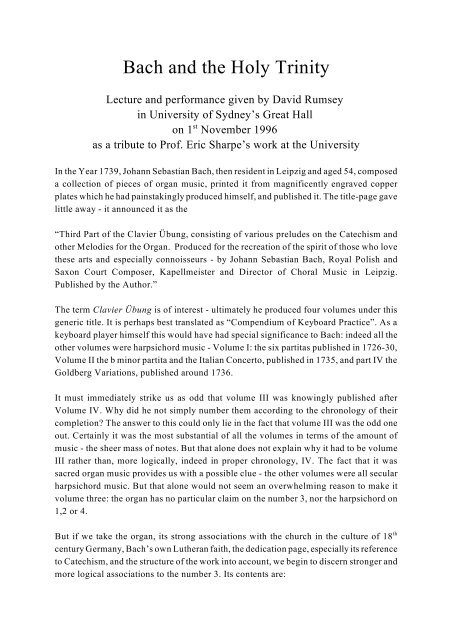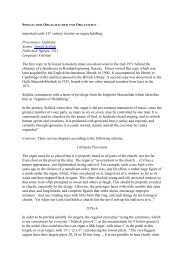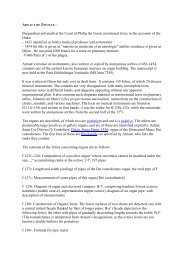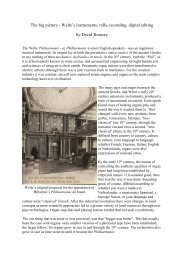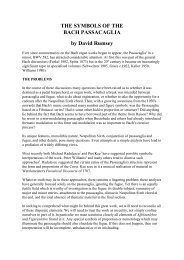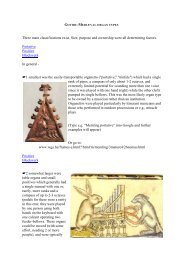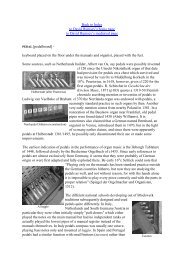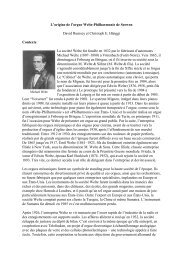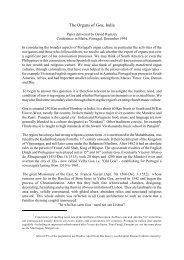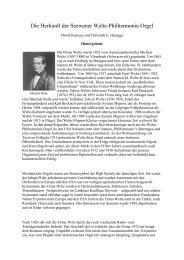Bach and the Holy Trinity - David Rumsey
Bach and the Holy Trinity - David Rumsey
Bach and the Holy Trinity - David Rumsey
You also want an ePaper? Increase the reach of your titles
YUMPU automatically turns print PDFs into web optimized ePapers that Google loves.
<strong>Bach</strong> <strong>and</strong> <strong>the</strong> <strong>Holy</strong> <strong>Trinity</strong><br />
Lecture <strong>and</strong> performance given by <strong>David</strong> <strong>Rumsey</strong><br />
in University of Sydney’s Great Hall<br />
st<br />
on 1 November 1996<br />
as a tribute to Prof. Eric Sharpe’s work at <strong>the</strong> University<br />
In <strong>the</strong> Year 1739, Johann Sebastian <strong>Bach</strong>, <strong>the</strong>n resident in Leipzig <strong>and</strong> aged 54, composed<br />
a collection of pieces of organ music, printed it from magnificently engraved copper<br />
plates which he had painstakingly produced himself, <strong>and</strong> published it. The title-page gave<br />
little away - it announced it as <strong>the</strong><br />
“Third Part of <strong>the</strong> Clavier Übung, consisting of various preludes on <strong>the</strong> Catechism <strong>and</strong><br />
o<strong>the</strong>r Melodies for <strong>the</strong> Organ. Produced for <strong>the</strong> recreation of <strong>the</strong> spirit of those who love<br />
<strong>the</strong>se arts <strong>and</strong> especially connoisseurs - by Johann Sebastian <strong>Bach</strong>, Royal Polish <strong>and</strong><br />
Saxon Court Composer, Kapellmeister <strong>and</strong> Director of Choral Music in Leipzig.<br />
Published by <strong>the</strong> Author.”<br />
The term Clavier Übung is of interest - ultimately he produced four volumes under this<br />
generic title. It is perhaps best translated as “Compendium of Keyboard Practice”. As a<br />
keyboard player himself this would have had special significance to <strong>Bach</strong>: indeed all <strong>the</strong><br />
o<strong>the</strong>r volumes were harpsichord music - Volume I: <strong>the</strong> six partitas published in 1726-30,<br />
Volume II <strong>the</strong> b minor partita <strong>and</strong> <strong>the</strong> Italian Concerto, published in 1735, <strong>and</strong> part IV <strong>the</strong><br />
Goldberg Variations, published around 1736.<br />
It must immediately strike us as odd that volume III was knowingly published after<br />
Volume IV. Why did he not simply number <strong>the</strong>m according to <strong>the</strong> chronology of <strong>the</strong>ir<br />
completion? The answer to this could only lie in <strong>the</strong> fact that volume III was <strong>the</strong> odd one<br />
out. Certainly it was <strong>the</strong> most substantial of all <strong>the</strong> volumes in terms of <strong>the</strong> amount of<br />
music - <strong>the</strong> sheer mass of notes. But that alone does not explain why it had to be volume<br />
III ra<strong>the</strong>r than, more logically, indeed in proper chronology, IV. The fact that it was<br />
sacred organ music provides us with a possible clue - <strong>the</strong> o<strong>the</strong>r volumes were all secular<br />
harpsichord music. But that alone would not seem an overwhelming reason to make it<br />
volume three: <strong>the</strong> organ has no particular claim on <strong>the</strong> number 3, nor <strong>the</strong> harpsichord on<br />
1,2 or 4.<br />
But if we take <strong>the</strong> organ, its strong associations with <strong>the</strong> church in <strong>the</strong> culture of 18 th<br />
century Germany, <strong>Bach</strong>’s own Lu<strong>the</strong>ran faith, <strong>the</strong> dedication page, especially its reference<br />
to Catechism, <strong>and</strong> <strong>the</strong> structure of <strong>the</strong> work into account, we begin to discern stronger <strong>and</strong><br />
more logical associations to <strong>the</strong> number 3. Its contents are:
2<br />
CLAVIERÜBUNG III<br />
1<br />
BWV<br />
552 Prelude in E� major<br />
2 669 Kyrie, Gott Vater in Ewigkeit, Canto fermo in Soprano, a 2 Clav. et Ped.<br />
3 670 Christe, aller Welt Trost Canto fermo in Tenore, a 2 Clav. et Pedal<br />
4 671 Kyrie, Gott heiliger Geist, à 5 Canto fermo in Basso, Cum Organo pleno<br />
5 672 Kyrie, Gott Vater in Ewigkeit alio modo, manualiter<br />
6 673 Christe, aller Welt Trost<br />
7 674 Kyrie, Gott heiliger Geist<br />
8 675 Allein Gott in der Höh' sei Ehr' à 3, Canto fermo in alto<br />
9 676 Allein Gott in der Höh' sei Ehr' a 2 Clav. et Pedal<br />
10 677 Fughetta super Allein Gott in der Höh' sei Ehr' manualiter<br />
11 678 Diess sind die heil'gen zehn Gebot a 2 Clav. et Ped., Canto fermo in canone<br />
12 679 Fughetta super Diess sind die heil'gen zehn Gebot /manualiter<br />
13 680 Wir glauben all' an einen Gott In Organo pleno con Pedale<br />
14 681 Fughetta super Wir glauben all' an einen Gott manualit:<br />
15 682 Vater unser in Himmelreich à 2 Clav. et Pedal è Canto fermo in Canone<br />
16 683 Vater unser im Himmelreich alio modo, manualiter<br />
17 684 Christ, unser Herr, zum Jordan kam a 2 Clav. è Canto fermo in Pedal<br />
18 685 Christ, unser Herr, zum Jordan kam alio modo, manualiter<br />
19 686 Aus tieffer Noth schrey ich zu dir a 6, in Organo pleno con Pedale doppio<br />
20 687 Aus tieffer Noth schrey ich zu dir a 4 alio modo, manualiter<br />
21 688 Jesus Christus, under Heil<strong>and</strong>, der von uns den Zorn Gottes w<strong>and</strong>t/a 2 Clav.<br />
e Canto fermo in Pedal<br />
22 689 Fuga super Jesus Christus, unser Heyl<strong>and</strong> a 4 manualiter<br />
23 “Duet” 1<br />
24 “Duet” 2<br />
25 “Duet” 3<br />
26 “Duet” 4<br />
27 552 Fugue in E� major<br />
We can summarize <strong>and</strong> categorise this structure as:<br />
Prelude Liturgical<br />
3 “Large” Kyrie settings (fa<strong>the</strong>r, son, holy ghost)}<br />
3 “Small” Kyrie settings (fa<strong>the</strong>r, son, holy ghost)} “Missa brevis”, Lu<strong>the</strong>ran Mass<br />
3 Glorias }<br />
12 (6 x twin settings) Catechism, <strong>the</strong>ology<br />
4 “duets” or 2-part inventions Johann Steglich = 4 elements<br />
Fugue Liturgical
3<br />
Here we are struck by <strong>the</strong> recurrence of <strong>the</strong> number 3: not only in <strong>the</strong> 3 groupings of 3<br />
Chorale settings forming <strong>the</strong> “Liturgical” section of <strong>the</strong> work, but <strong>the</strong> total of 3x3x3, ie<br />
27 pieces. Fur<strong>the</strong>r investigations which we will make later add to this <strong>the</strong> fact that <strong>the</strong><br />
Prelude has Three Themes, <strong>and</strong> <strong>the</strong> fugue is a Triple Fugue, with 3x3x3 entries of its<br />
<strong>the</strong>me.<br />
As we shall see, this consistency of encrypting <strong>the</strong> number three into this collection may<br />
have something to do with <strong>the</strong> apparently illogical chronology of publication of <strong>the</strong>se four<br />
volumes. Clearly Trinitarian concepts would be <strong>the</strong> most logical connection to inspire<br />
such musical structures - but if this common assumption is indeed true we must weigh it<br />
up against <strong>the</strong> fact that <strong>the</strong> <strong>Trinity</strong> is not expressly mentioned in <strong>the</strong> Dedication, ra<strong>the</strong>r it<br />
speaks of Catechism <strong>and</strong> Hymns.<br />
I intend to investigate here some links between <strong>the</strong>ology <strong>and</strong> doctrine, <strong>the</strong> motivation that<br />
<strong>Bach</strong> could have had to produce such a dedicated volume, <strong>the</strong> support which known<br />
th<br />
musical practice <strong>and</strong> general culture of <strong>the</strong> 18 century might give in particular to <strong>the</strong><br />
<strong>Trinity</strong>-hypo<strong>the</strong>sis in this connection, particularly <strong>the</strong> Prelude <strong>and</strong> Fugue which open <strong>and</strong><br />
close it, <strong>the</strong>n play <strong>the</strong>m for you on <strong>the</strong> Great Hall organ.<br />
TRINITY<br />
The <strong>the</strong>ology of <strong>the</strong> Christian <strong>Trinity</strong> is a fascinating phenomenon: it has virtually no<br />
Biblical justification, was <strong>the</strong> cause of considerable doctrinal argument over <strong>the</strong> past 2<br />
millennia, <strong>and</strong> challenges <strong>the</strong> very foundations of “one God” with what sounds<br />
suspiciously like tri<strong>the</strong>ism. Never<strong>the</strong>less after <strong>the</strong> turbulent first few centuries of<br />
Christianity most denominations, including <strong>the</strong> followers of Martin Lu<strong>the</strong>r, accepted <strong>the</strong><br />
doctrine of <strong>the</strong> Three-in-One. However Unitarianism developed in central Europe in <strong>the</strong><br />
very century of <strong>the</strong> Lu<strong>the</strong>ran Reformation <strong>and</strong> a problem at one time for that Church was<br />
Socinianism or Socinism - this held similar views to Unitarians.<br />
All evidence points to <strong>the</strong> fact that Johann Sebastian <strong>Bach</strong> was an orthodox Lu<strong>the</strong>ran,<br />
embracing <strong>the</strong> firm <strong>and</strong> normal beliefs of that faith in <strong>the</strong> <strong>Trinity</strong>. The rise <strong>and</strong><br />
th<br />
development of 17 Century German Pietism had its influence on him, <strong>and</strong> we do have<br />
slight evidence - notwithst<strong>and</strong>ing some parts of his Passion Music, that he was not always<br />
comfortable with <strong>the</strong> inequalities inherent in any tendency to Christ-centred<br />
Trinitarianism.<br />
We should also remember here just how important music was to Lu<strong>the</strong>r <strong>and</strong> his followers:<br />
th th<br />
this manifested itself in strong links between music <strong>and</strong> rhetoric in 17 <strong>and</strong> 18 century<br />
Germany.
4<br />
Rhetorical traditions date back to classical Greece - Aristotle, Cicero, Quintilian <strong>and</strong><br />
o<strong>the</strong>rs. But it was <strong>the</strong> German Reformation that provided special links between rhetoric<br />
<strong>and</strong> music. Lu<strong>the</strong>r encouraged <strong>the</strong> concept that music was not merely a beautiful art form,<br />
but ranked “next to <strong>the</strong>ology”. During <strong>the</strong> Renaissance music began to shift from a<br />
ma<strong>the</strong>matical discipline (where it had co-existed with astronomy, ma<strong>the</strong>matics, <strong>and</strong><br />
geometry in <strong>the</strong> quadrivium of <strong>the</strong> seven liberal arts) to <strong>the</strong> predominantly linguistic <strong>and</strong><br />
humanistic disciplines associated with <strong>the</strong> trivium (logic, grammar, <strong>and</strong> rhetoric). As early<br />
as 1537 we have written evidence of Lu<strong>the</strong>ran connections between rhetoric <strong>and</strong> music<br />
in a textbook, Musica, for use in German classrooms. It was written by Nicolaus<br />
Listenius, a Wittenberg schoolmaster. Direct evidence of <strong>Bach</strong>’s links with rhetorical<br />
practice <strong>and</strong> its application to music, exist inter alia in his friendship with Abraham<br />
Birnbaum, instructor in rhetoric at <strong>the</strong> University of Leipzig.<br />
Thus Lu<strong>the</strong>ranism evolved a strong equality between bible <strong>and</strong> hymn-book, between<br />
Pastor <strong>and</strong> Cantor in <strong>the</strong> ecclesiastical culture of this era. A Cantor such as <strong>Bach</strong> would<br />
have seen himself, <strong>and</strong> been seen, as a kind of musical Pastor, with equal authority <strong>and</strong><br />
responsibility: <strong>the</strong> religious message <strong>and</strong> leadership was <strong>the</strong> same, <strong>the</strong> rhetoric of <strong>the</strong><br />
preaching <strong>the</strong> same, but <strong>the</strong> medium was music ra<strong>the</strong>r than speech.<br />
In that connection <strong>and</strong> in this culture we can observe <strong>Bach</strong>’s musical preaching as not<br />
only <strong>the</strong> week-by-week duties of creating <strong>and</strong> performing music for <strong>the</strong> services, but from<br />
time to time issuing great statements of faith literally speaking through his music, a<br />
preaching <strong>and</strong> teaching medium appropriate for a Cantor. At all stages in his life he<br />
produced monumental statements of this kind:<br />
Liturgy (b-minor mass 1730's)<br />
Church Seasons (Christmas - Canonic Variations, Christmas Oratorio; Easter -<br />
Easter Oratorio, Passion: Johannes, Matthäus <strong>and</strong> o<strong>the</strong>rs, now lost).<br />
Organ Music was a naturally favoured medium for this kind of activity:<br />
Orgelbüchlein of 1717, Schübler of 1747, <strong>the</strong> “Eighteen Chorales”, <strong>the</strong><br />
Passacaglia an early essay into Covenant Theology, all involve strong<br />
liturgical <strong>and</strong>/or doctrinal <strong>and</strong> <strong>the</strong>ological considerations.<br />
Indeed it would have been strange had he not, in this lifetime of musical preaching,<br />
dedicated something major to <strong>the</strong> <strong>Holy</strong> <strong>Trinity</strong>.<br />
Not that <strong>the</strong> <strong>Trinity</strong> went unacknowledged: we find a few references to Trinitarianism as<br />
such in many of his works. Elements appear in <strong>the</strong> earlier works, such as Orgelbüchlein,<br />
some of <strong>the</strong> Cantatas, <strong>the</strong> extant Passions, <strong>the</strong> b minor Mass. But it is generally only<br />
insofar as Fa<strong>the</strong>r, Son or <strong>Holy</strong> Ghost are mentioned briefly <strong>and</strong> separately. Cantata 176
5<br />
“Es ist ein trotzig und verzagt Ding” may represent an attempt for <strong>Bach</strong> to deal more<br />
explicitly with this doctrine in his use of Paul Gerhard’s <strong>Trinity</strong> hymn as <strong>the</strong> closing<br />
chorale. If it is - <strong>and</strong> <strong>the</strong> incidence appears meaningful <strong>and</strong> preliminary ra<strong>the</strong>r than critical<br />
<strong>and</strong> developed in <strong>the</strong> global context of <strong>Bach</strong>’s music - <strong>the</strong>n at least we can date an<br />
elevated interest in <strong>Trinity</strong> concepts from this cantata: 1732. This might be significant,<br />
since <strong>the</strong> work we shall be considering in a moment was completed only 7 years later.<br />
But until <strong>the</strong> Clavierübung III <strong>the</strong> total concept of <strong>the</strong> <strong>Trinity</strong> - as important as it was -<br />
was never exhaustively treated by <strong>Bach</strong>. We can imagine that <strong>the</strong> Thomaskantor was very<br />
conscious of this - particularly as it was by <strong>the</strong>n one of <strong>the</strong> only significant remaining<br />
doctrines, church seasons or <strong>the</strong>ologies that he had omitted to turn his full attention to.<br />
Nor could he so easily have done this since <strong>the</strong> <strong>Trinity</strong> is not actually Biblical <strong>and</strong> <strong>Bach</strong><br />
treated mainly biblical texts (or poetic versions of <strong>the</strong>se) in his Cantatas, Passions, or<br />
organ chorale settings. There is no scriptural textual possibility, <strong>and</strong> <strong>the</strong> chorale books<br />
have an amazingly limited repertoire of actual <strong>Trinity</strong> hymns - for example even today <strong>the</strong><br />
German Lu<strong>the</strong>ran Church has only 3 specifically-identified trinity hymns.<br />
By 1739 time was certainly ripe for attention to <strong>the</strong> <strong>Trinity</strong>, but whe<strong>the</strong>r <strong>the</strong> Pietists or<br />
simply <strong>the</strong> <strong>Trinity</strong>-free zone created by earlier music caused <strong>the</strong> prime motivation for<br />
<strong>Bach</strong> is not yet clear. Never<strong>the</strong>less <strong>the</strong> opportunity to assert <strong>Trinity</strong> doctrine against <strong>the</strong><br />
disturbances created by Unitarians or Socinians could have been a consideration.<br />
TH<br />
THE LANGUAGE AND CULTURE OF 18 CENTURY MUSIC<br />
The culture of <strong>Bach</strong>’s contemporaries was rich in literary <strong>and</strong> musical pastimes <strong>and</strong><br />
symbolism. <strong>Bach</strong> himself wrote puzzle-canons, his students presented him with chalices<br />
which bore meaningful <strong>and</strong> secret-encoded inscriptions, one of his librettists, <strong>the</strong> famous<br />
Pic<strong>and</strong>er, was involved in Cabbala-related numerology, <strong>and</strong> books were published<br />
throughout this time leaving no doubt that <strong>the</strong>re were dimensions of symbolism <strong>and</strong><br />
numerology in all art, including literature <strong>and</strong> music. Music went far beyond <strong>the</strong><br />
superficial process of just placing nice-sounding notes on a piece of manuscript paper.<br />
This culture, its clearly-documented philosophy, practice, <strong>and</strong> developed musical<br />
language, were all different from our own <strong>and</strong> cannot be judged from our own<br />
perspectives without prior investigation.<br />
th<br />
In a lecture which I gave on 4 September 1996 for <strong>the</strong> Society of Literature <strong>and</strong><br />
Aes<strong>the</strong>tics at <strong>the</strong> University of Sydney, aspects of <strong>Bach</strong>’s compositional processes were<br />
th<br />
investigated. In particular his application of 18 Century Musical Affektenlehre,<br />
Figurenlehre, Biblical Symbolism <strong>and</strong> Cabbala-derived Numerology were related to his
musical textures, expression <strong>and</strong> structures.<br />
6<br />
The use of paragrams <strong>and</strong> gematria in <strong>Bach</strong>’s literary, rhetorical <strong>and</strong> ma<strong>the</strong>matical culture<br />
was shown to exist in his music. The variety of available number-alphabets - Latin<br />
milesian, Latin natural order, Pyramidal, dodecangular, octangular, cubica <strong>and</strong> so on - was<br />
investigated <strong>and</strong> proof offered that Ruth Tatlow’s Latin Natural Order variant one was<br />
<strong>the</strong> only such alphabet <strong>Bach</strong> could have used. This coincidentally also proved statistically<br />
beyond all reasonable doubt (to better than 1 in 5 trillion trillion trillion) that <strong>Bach</strong> was<br />
active in this area. To those who were <strong>the</strong>re I trust that I need offer no fur<strong>the</strong>r justification<br />
for what I am about to say. For those who were not I beg of you, if necessary, to take a<br />
temporary leap-of-faith in accepting some of <strong>the</strong> material which now follows. Viewed<br />
from a twentieth century perspective it may seem far-fetched, but from a mid-eighteenth<br />
century perspective it was a quite normal practice in religious, literary <strong>and</strong> musical fields.<br />
th<br />
In <strong>the</strong> course of that paper I discussed certain elements of this 18 century German<br />
musical language:<br />
1) Affektenlehre - known in English as “Doctrine of <strong>the</strong> Affections”:<br />
was <strong>the</strong> belief held in <strong>the</strong> 17th <strong>and</strong> early 18th Centuries, that <strong>the</strong> principal<br />
aim of music is to arouse <strong>the</strong> passions or affections (love, hate, joy, anger,<br />
1<br />
fear, etc., conceived as rationalised, discrete <strong>and</strong> relatively static states) .<br />
th<br />
2) Figurenlehre, a fully documented 18 century practice of music defined as<br />
“Any of various attempts made in <strong>the</strong> 17th <strong>and</strong> 18th Centuries to codify<br />
music according to classes of musical figures thought to be analogous to<br />
2<br />
<strong>the</strong> figures of rhetoric” .<br />
And fur<strong>the</strong>rmore:<br />
1<br />
2<br />
3<br />
“. . . <strong>the</strong> whole of <strong>the</strong> Baroque Affektenlehre was predicated on<br />
[hermeneutics], <strong>and</strong> all composers of <strong>the</strong> age attempted to portray words,<br />
even ideas, by using musical figures that have a pictorial quality expressible<br />
in <strong>the</strong> very graphic image of <strong>the</strong> score. . .” 3<br />
ed. Don R<strong>and</strong>el, The New Harvard Dictionary of Music, Belknap Harvard<br />
ed. Don R<strong>and</strong>el, The New Harvard Dictionary of Music, Belknap Harvard<br />
Paul Henry Lang George Frideric H<strong>and</strong>el (Faber & Faber) especially pp.624ff.
7<br />
3) Biblical Ma<strong>the</strong>matics - also abundantly documented - particularly in evidence during<br />
<strong>Bach</strong>’s lifetime - from <strong>the</strong> “Paradoxal-Discourse” of Andreas Werckmeister (1707) to<br />
Johann Jacob Schmidt’s Biblische Ma<strong>the</strong>maticus of 1736. These writers were concerned<br />
with such matters as <strong>Holy</strong> numbers, 3 <strong>and</strong> 7, <strong>the</strong> 77 generations from Adam to Christ, <strong>and</strong><br />
so on. Typically, Werckmeister’s“Paradoxal-Discourse” chapter 19 is entitled “Von der<br />
Zahlen geheimen Deutung”(“Of <strong>the</strong> secret meaning of numbers”). It gives a basic listing<br />
of number-symbols, conjuring up distinct memories of Leibnitz who claimed that Music<br />
is an “unconscious exercise in arithmetic”. Werckmeister wrote:<br />
“.... <strong>the</strong> musical intervals are nothing o<strong>the</strong>r than numbers <strong>and</strong> proportions<br />
<strong>and</strong> since God created <strong>and</strong> ordered everything in Numbers, Proportion <strong>and</strong><br />
weighting, so also must <strong>the</strong> musician, indeed every person, be diligent <strong>and</strong><br />
study how to reproduce such marvellous Order.”<br />
4) The use of Number Alphabets (gematria) to derive numerological equivalents to<br />
names. Thus <strong>Bach</strong>’s name was expressible as <strong>the</strong> number 14: B=2+A=1+C=3+H=4 sums<br />
to 14. The German Musicologist Friedrich Smend in particular has dealt exhaustively with<br />
4<br />
this subject, especially in his book on <strong>the</strong> Cantatas of <strong>Bach</strong> . Contemporary references<br />
from musicians <strong>and</strong> writers of <strong>Bach</strong>’s time leave us in no doubt that this was a common<br />
currency of art <strong>and</strong> life.<br />
5) Musical Cryptography: This was <strong>the</strong> practice of encrypting references in a composition,<br />
everything from a composer’s name, such as <strong>Bach</strong>’s own documented use of <strong>the</strong> notes<br />
B�-A-C-B� (in <strong>the</strong> German musical notation <strong>the</strong>se notes are read as B-A-C-H) to<br />
Frederick IIIrd’s presumed ascension to Heaven in a commemorative piece written by<br />
Johann Jacob Froberger (1616-1667) which concludes with an ascending F major scale<br />
culminating on 3 repeated F’s <strong>and</strong> a drawing showing Frederick levitating in clouds.<br />
th th<br />
It is difficult in <strong>the</strong> late 20 century to sort out what occurred in <strong>the</strong> mid-18 by chance<br />
or intentionally in such peripheral <strong>and</strong> normally undocumented adjuncts as numerology<br />
<strong>and</strong> symbolism. In art forms where <strong>the</strong>y lurk as cryptography in music we are happy to<br />
identify any mutually-supporting proofs. Thus it is a non-sequitur to say that every<br />
ascending F-major scale represents Frederick IIIrd’s ascension to heaven. However, three<br />
repeated F’s at <strong>the</strong> top, plus <strong>the</strong> title dedication or known intent of <strong>the</strong> piece, plus a<br />
drawing of Frederick up in <strong>the</strong> clouds, <strong>and</strong> <strong>the</strong> knowledge that this was accepted cultural<br />
practice at <strong>the</strong> time, leaves us in a much better position to see with more certainty <strong>the</strong><br />
4<br />
J. S. <strong>Bach</strong> Kirchen Kantaten, Friedrich Smend, Christliche Zeitschriftenverlag ISBN<br />
Berlin 1966
symbolism that was intended.<br />
8<br />
Thus <strong>the</strong> pre-occupation with Trinitarian concepts in <strong>the</strong> Kyries of Clavierübung Part III<br />
is <strong>the</strong> unavoidable textual reference revealing strong Trinitarian elements. The “large”<br />
settings are momentous pieces of music where <strong>the</strong> first identifies "Kyrie eleison" with<br />
"Gott Vater in Ewigkeit" <strong>and</strong> puts <strong>the</strong> chorale in <strong>the</strong> upper part. The second, “Christe aller<br />
Welt Trost” places <strong>the</strong> chorale in <strong>the</strong> middle of <strong>the</strong> texture as a tenor part. The final<br />
“Kyrie, Gott Heiliger Geist” places its chorale melody deep down in <strong>the</strong> pedal part. Here<br />
we have <strong>Trinity</strong> symbolism at work in both a literary <strong>and</strong> musico-pictorial sense.<br />
A clear basic symbolism is at work here. Where did it originate? One possible answer<br />
may be that, in <strong>the</strong> era immediately preceding <strong>Bach</strong>, <strong>the</strong> Protestant North suppressed<br />
<strong>the</strong>atrical activity, especially Opera <strong>and</strong> its derivatives. For his Leipzig position <strong>Bach</strong> was<br />
expressly forbidden, in his terms of contract article 7, to allow <strong>the</strong> music to become<br />
operatic:<br />
"7. To <strong>the</strong> end that good order may prevail in those churches I should so<br />
arrange <strong>the</strong> music that it may not last too long, <strong>and</strong> also in such wise that<br />
it may not be operatic, but incite <strong>the</strong> hearers to devotion."<br />
In <strong>the</strong> organ music of <strong>the</strong> Protestant North, however, <strong>the</strong>re was a specially dramatic,<br />
th th<br />
almost romantic creativity applied in <strong>the</strong> 17 <strong>and</strong> early 18 centuries. It was as if one<br />
sense had been lost <strong>and</strong> ano<strong>the</strong>r increased to compensate - like a blind person’s improved<br />
perception through hearing <strong>and</strong> touch. One feature of this <strong>the</strong>atrical <strong>and</strong> dramatic organ<br />
style was identified as “stylus phantasticus” - a free, quasi-improvised, style of composing<br />
<strong>and</strong> playing which might be likened to fire <strong>and</strong> brimstone sermonising. One of my<br />
students traced some interesting links between <strong>the</strong> Italian commedia dell’arte <strong>and</strong> North<br />
German stylus phantasticus a few years ago. The outcome of all this was to invest organ<br />
music with a kind of responsibility to represent or symbolise, even bring <strong>the</strong> suppressed<br />
<strong>the</strong>atre right into <strong>the</strong> hallowed precincts of ecclesia. No wonder <strong>the</strong>re grew up to be a<br />
common perception that, if ever <strong>the</strong> devil was going to enter <strong>the</strong> church it would be<br />
through <strong>the</strong> choir loft!<br />
In <strong>the</strong> 18 century art of organ playing <strong>the</strong> practice of playing or improvising organ music<br />
th<br />
to replace a hymn verse where <strong>the</strong> congregation remain silently listening was well<br />
cultivated or forems such as Chorale Fantasia were dedicated to use during communion.<br />
We know from contemporary accounts, as well as <strong>the</strong> music which has survived, that <strong>the</strong><br />
highest examples of this art were expressly destined to interpret <strong>the</strong> <strong>the</strong>ology <strong>and</strong> concepts<br />
of <strong>the</strong> relevant verse, using proper Figur <strong>and</strong> Affekt. And sometimes, it seems,<br />
numerology plays a part in <strong>the</strong> creative <strong>and</strong> symbolic process.
9<br />
So it should be no surprise to us if we discover that major examples of organ music from<br />
this era, especially that of <strong>Bach</strong>, are impregnated with symbols <strong>and</strong> representations.<br />
Indeed it might be surprising if <strong>the</strong>y were not.<br />
CLAVIERÜBUNG III<br />
In investigating <strong>the</strong> Clavierübung part III, we cannot help but be struck by <strong>the</strong> consistent<br />
appearance of <strong>the</strong> number “3", which, according to numerology practices of <strong>the</strong> past two<br />
millennia was a symbol for Holiness or <strong>Trinity</strong>:<br />
rd<br />
The Collection is <strong>the</strong> 3 part of <strong>the</strong> 4 volumes of Clavierübung, <strong>the</strong> one linked expressly<br />
to <strong>the</strong> church by being organ music, <strong>the</strong> one which came fourth <strong>and</strong> was numbered third.<br />
* The 27 pieces of <strong>the</strong> work represent a ma<strong>the</strong>matical product: 3x3x3<br />
* The prelude <strong>and</strong> fugue, its great supporting pillars, both have <strong>the</strong> key signature of E�<br />
major, where three notes of <strong>the</strong> diatonic musical scale are altered.<br />
* The prelude has three distinctive <strong>the</strong>mes<br />
* The fugue is what is technically known as a “triple” fugue.<br />
The Prelude <strong>and</strong> Fugue form <strong>the</strong> alpha <strong>and</strong> omega, <strong>the</strong> two great supporting pillars of this<br />
collection of 27 pieces. <strong>Bach</strong> provides <strong>the</strong> Prelude with three <strong>the</strong>mes: <strong>the</strong> first a majestic,<br />
dotted rhythm <strong>the</strong>me using both <strong>the</strong> Affekt <strong>and</strong> Figur of a French overture - a common<br />
form of music at <strong>the</strong> time. Such Figuren were used to represent Royalty or nobility in<br />
music of this or virtually any era since <strong>the</strong>n. The second <strong>the</strong>me is structured in two parts -<br />
first, a chordal remnant of <strong>the</strong> original <strong>the</strong>me, modifying but maintaining regal<br />
associations but now adding echo effects; second, a syncopated <strong>and</strong> chromatic sequence<br />
reminiscent of <strong>the</strong> musical language <strong>Bach</strong> reserved for Passion <strong>and</strong> crucifixion subjects.<br />
The third <strong>the</strong>me is quickly-moving, it starts with a scale in octave descent, <strong>the</strong>n moves<br />
around its lower note in an elaborated figuration.<br />
At this point we might say that <strong>Bach</strong> was simply free to create some music in a single<br />
dimension which was interesting - even entertaining. Both Prelude <strong>and</strong> Fugue certainly<br />
achieve <strong>the</strong>se qualities with ease <strong>and</strong> have become deservedly popular works. But when<br />
we view <strong>the</strong>m in <strong>the</strong> second dimension as pieces of representational music we open <strong>the</strong><br />
possibility for studying <strong>the</strong>ir musical language <strong>and</strong> interpret any underlying symbols.<br />
Thus, <strong>the</strong> first <strong>the</strong>me can be seen as a representation of <strong>the</strong> might <strong>and</strong> nobility - "Royalty"<br />
- of God <strong>the</strong> Fa<strong>the</strong>r.<br />
The two parts of <strong>the</strong> second <strong>the</strong>me might represent <strong>the</strong> dual nature of God (in <strong>the</strong>
10<br />
similarity of Affekt <strong>and</strong> Figur <strong>and</strong> <strong>the</strong> echoing, i.e. reproducing or making in its image, of<br />
<strong>the</strong> "Fa<strong>the</strong>r" <strong>the</strong>me) <strong>and</strong> <strong>the</strong> second part of it betokening God made Man (<strong>the</strong> associations<br />
with <strong>the</strong> musical language of Passion <strong>and</strong> Crucifixion).<br />
The third <strong>the</strong>me is a descent of one octave, recalling for us <strong>the</strong> sphaera octava, or octave<br />
of <strong>the</strong> spheres, which since ancient Greece, through <strong>the</strong> polymaths such as Henri Arnaut,<br />
<strong>the</strong> era of Newton, Viviani <strong>and</strong> Kepler, was a symbol for <strong>the</strong> relationship between <strong>the</strong><br />
cosmic bodies, especially heaven <strong>and</strong> earth. The elaborated moving about in <strong>the</strong> lower<br />
tessitura is an ideal representation of <strong>the</strong> <strong>Holy</strong> Ghost on earth, also used by <strong>Bach</strong> in o<strong>the</strong>r<br />
contexts.<br />
Not only do <strong>the</strong>se <strong>the</strong>mes provide most appropriate representations but <strong>the</strong>y are<br />
introduced in <strong>the</strong> normal order of Fa<strong>the</strong>r first, Son second, <strong>and</strong> <strong>Holy</strong> Ghost third. The<br />
Prelude is immediately followed by three pieces textually identified specifically with<br />
Fa<strong>the</strong>r, Son <strong>and</strong> <strong>Holy</strong> Ghost, again in that order. These are followed by three smaller<br />
versions with identical titles in identical order.<br />
The unusual choice of key for <strong>the</strong> Prelude - <strong>Bach</strong>’s only free organ work in E� major -<br />
th<br />
invites attention. This key was normally out of <strong>the</strong> question for 18 century composers<br />
on account of <strong>the</strong> keyboard tempering <strong>and</strong> tuning practice of <strong>the</strong> day: its sub-dominant,<br />
A� major, was a tense <strong>and</strong> out-of-tune key suitable only to provide Affekten of agony, but<br />
o<strong>the</strong>rwise normally avoided. The beginning of “Thy rebuke has broken his heart” from<br />
H<strong>and</strong>el’s Messiah is an example of <strong>the</strong> deliberate use of dissonant A� major, colouring<br />
<strong>and</strong> interpreting <strong>the</strong> text. But <strong>the</strong> key signature of E� major is a 3-symbol of its own<br />
accord for it indicates to <strong>the</strong> performer that three notes in each octave are to be read as<br />
flattened accidentals. Moreover <strong>the</strong> tension <strong>and</strong> dissonance from <strong>the</strong> A� major tonality<br />
<strong>and</strong> beyond are specifically used in <strong>the</strong> second <strong>the</strong>me, second part, <strong>the</strong> one which seems<br />
to represent <strong>the</strong> human nature of Christ.<br />
An interesting point of Biblical numerology also comes out in this “human” <strong>the</strong>me in that<br />
it has a most unusual ornament - technically termed an appoggiatura, a short grace-note<br />
used to add an Affekt of sighing, or longing - human attributes, passion attributes. The<br />
unusual thing about <strong>Bach</strong>’s appoggiatura in this case is that instead of being <strong>the</strong> normally<br />
adjacent note, he writes one which leaps a fifth. According to Werckmeister in early 18th<br />
century, <strong>and</strong> Schmidt in Biblische Ma<strong>the</strong>maticus of 1736 - just 3 years before <strong>the</strong> piece<br />
we are discussing was composed:<br />
“5 is associated with weakness or Fall of Man”.<br />
So we can see in this Prelude a confluence of Biblical symbolism <strong>and</strong> o<strong>the</strong>r numerology,
11<br />
Affektenlehre, Figurenlehre, <strong>and</strong> text associations, cryptography <strong>and</strong> <strong>the</strong> obvious intent<br />
of <strong>the</strong> succeeding pieces all mutually supporting Trinitarian concepts.<br />
To help confirm this association we should also investigate <strong>the</strong> fugue - since Preludes <strong>and</strong><br />
Fugues are normally coupled with each o<strong>the</strong>r, here <strong>the</strong>y also form <strong>the</strong> extremities of a<br />
collection, <strong>the</strong>n <strong>the</strong>y might be expected to relate to each o<strong>the</strong>r. <strong>Bach</strong> chosen <strong>the</strong> same<br />
unusual key for <strong>the</strong> fugue - that coupled preludes fugues normally are in <strong>the</strong> same key is<br />
granted, although in this case <strong>the</strong>re are 25 pieces of music separating <strong>the</strong>m. More<br />
importantly, if we find no Trinitarian concepts expressed in <strong>the</strong> Fugue it will damage our<br />
case for a Trinitarian Prelude or indeed collection.<br />
The similarity of <strong>the</strong> final fugue <strong>the</strong>me to <strong>the</strong> first line of <strong>the</strong> English Hymn “O God our<br />
help in ages past” traditionally sung to <strong>the</strong> tune "St. Ann", accounts for its nickname in<br />
English-speaking circles: <strong>the</strong> “St. Ann” fugue. There is absolutely no evidence that <strong>Bach</strong><br />
knew this hymn. He did not appear to speak or read English. His son, Johann Christian<br />
<strong>Bach</strong>, did not even arrive in Engl<strong>and</strong> until twelve years after Johann Sebastian’s death.<br />
It has been pointed out that if <strong>the</strong> first two notes of <strong>the</strong> <strong>the</strong>me are reversed it yields <strong>the</strong> old<br />
German Chorale “Was Gott tut das is wohlgetan”. This would certainly be much more<br />
likely but is still not unproblematic. At any rate nei<strong>the</strong>r of <strong>the</strong> hymns has any specifically<br />
Trinitarian connotations.<br />
Much has been published about this music, including Friedrich Smend’s book J. S. <strong>Bach</strong><br />
Kirchen Kantaten, <strong>and</strong> Melbourne organist <strong>and</strong> scholar John O’Donnells’ article of 1976,<br />
“And yet <strong>the</strong>y are not three fugues: but one fugue”.<br />
Smend notes that <strong>the</strong> fugue <strong>the</strong>me has exactly seven notes, <strong>the</strong>n points out <strong>the</strong> reoccurrence<br />
here of <strong>the</strong> number 27: <strong>the</strong>re are exactly 27 entries of this 7-note fugue <strong>the</strong>me.<br />
O’Donnell identifies a total of 189 “tacti”, according to <strong>the</strong> old concepts of musical<br />
rhythmic order in <strong>Bach</strong>’s day. 189 is 27 x 7. But of particular interest is <strong>the</strong> fact that <strong>the</strong>se<br />
189 tacti are arranged symmetrically as 72 in <strong>the</strong> first fugue, 45 in <strong>the</strong> second, <strong>and</strong> 72<br />
again in <strong>the</strong> third, a proportion of 8:5:8. In any performance of <strong>the</strong> work this yields some<br />
interesting proportions:<br />
[Fugue II]:[Fugue I] = 5:8<br />
[Fugue I]:[Fugue I+II]=[Fugue III]:[Fugue II+III]=8:13<br />
[Fugue I+II]:[Fugue I+II+III]=[Fugue II+III]:[Fugue I+II+III]=13:21<br />
Now <strong>the</strong> numbers 5,8,13,21 belong to a Fibonacci series out of which is derived <strong>the</strong> socalled<br />
“Golden Section” - thus not only satisfying both Werckmeister <strong>and</strong> Leibnitz on<br />
proportions <strong>and</strong> music being a branch of ma<strong>the</strong>matics, but also conjuring up Kepler who
12<br />
called this ratio <strong>the</strong> “sectio divina”, divine section. Here it can be seen as an expression<br />
not of equality in <strong>the</strong> <strong>Trinity</strong>, but perfection <strong>and</strong> <strong>the</strong> unique relationship among <strong>the</strong> three<br />
persons:<br />
“For only by use of <strong>the</strong> Golden Section is it possible to portray <strong>the</strong> Son in<br />
<strong>the</strong> same relationship to <strong>the</strong> Fa<strong>the</strong>r, of whom he is begotten, as <strong>the</strong> <strong>Holy</strong><br />
Spirit is to <strong>the</strong> Fa<strong>the</strong>r <strong>and</strong> <strong>the</strong> Son, from whom he proceeds”.<br />
CONCLUSION<br />
Thus we see <strong>the</strong> mutual connection between prelude <strong>and</strong> fugue <strong>and</strong> <strong>the</strong>ir relationship with<br />
<strong>the</strong> whole collection is seeped in Trinitarianism. The Clavierübung part III, must be seen<br />
as a representation, not only of <strong>the</strong> commonly-held biblical beliefs <strong>and</strong> doctrines, clearly<br />
identified in its dedication as Catechism, but an expression of Church Life, with its<br />
Liturgical elements. There are fur<strong>the</strong>r connections with world creation <strong>the</strong>ory in <strong>the</strong> four<br />
duets, all presented in <strong>the</strong> context of <strong>the</strong> doctrine of <strong>the</strong> <strong>Trinity</strong>. In its own way it is<br />
perhaps a kind of christian cosmology. From this we may glean a possible explanation as<br />
to why Volume III was published after Volume IV, for a collection devoted to <strong>the</strong> <strong>Trinity</strong><br />
could only be number III in a culture where symbolism <strong>and</strong> numerology was so important.<br />
It would be tempting to speculate whe<strong>the</strong>r <strong>Bach</strong>, <strong>the</strong> Cantor <strong>and</strong> musical Pastor,<br />
preaching his own sermon on <strong>the</strong> <strong>Holy</strong> <strong>Trinity</strong> through this collection of music. If that was<br />
<strong>the</strong> case <strong>the</strong>n Clavierübung III is using music, <strong>the</strong> h<strong>and</strong>maiden of religion, to explain this<br />
ancient concept in totally clear logical <strong>and</strong> precise ma<strong>the</strong>matical terms. Certainly <strong>Bach</strong>’s<br />
music can be regarded as <strong>the</strong> culmination of <strong>the</strong> ancient quadrivium, where ma<strong>the</strong>matics<br />
<strong>and</strong> music were part of <strong>the</strong> one set of related disciplines.<br />
Eric, - in a moment I will do <strong>the</strong> great Wurlitzer race to <strong>the</strong> far end of <strong>the</strong> Great Hall <strong>and</strong><br />
play this Prelude <strong>and</strong> Fugue. Our personal association <strong>and</strong> your support over many years<br />
has been one that has enriched my life <strong>and</strong> that of our mutual communities in many ways.<br />
It has produced three interdisciplinary symposia between our respective academic areas<br />
here at <strong>the</strong> University <strong>and</strong> Conservatorium, led to many pleasurable moments sailing,<br />
dining <strong>and</strong> living. In particular <strong>the</strong> religious <strong>and</strong> musical connections have been a mutual<br />
enhancement both socially <strong>and</strong> academically. Your humour is not forgotten: how could<br />
it be after I conducted a <strong>Bach</strong> Cantata with Eric as soloist <strong>the</strong>n later being greeted in <strong>the</strong><br />
local supermarket with a burst of his aria “Bestelle dein Haus”. It may be insider-trading<br />
to some extent but I know that <strong>the</strong> Prelude in E� major was played at your wedding - so<br />
<strong>the</strong> opportunity to conclude today’s ga<strong>the</strong>ring with music, which we all know is of such<br />
importance to you, was natural <strong>and</strong> irresistible. Since I shall be playing both Prelude <strong>and</strong><br />
Fugue today you might now be able to claim that <strong>the</strong> prelude was played at your wedding
13<br />
to Birgitta <strong>and</strong> <strong>the</strong> Fugue at your divorce from <strong>the</strong> University.<br />
© <strong>David</strong> <strong>Rumsey</strong> 7th November 1996


